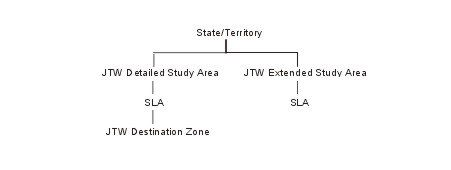GENERAL DESCRIPTION
Journey to work (JTW) data provide information about where people work rather than where they reside. This information is used by State Transport Authorities to assist with planning transport systems in their State or Territory.
JTW data have been produced from the Census of Population and Housing since 1971. The geographical areas are redefined each census to take into account changes and growth that occur over time in the States and Territories. As a result, the data are not comparable across censuses. For the 2001 Census, the geographic scope was widened to include the whole of geographic Australia (excluding the external territories of Jervis Bay, Christmas Island and Cocos (Keeling) Islands). Thus, the applicable population for JTW data has increased to allow a more comprehensive view of work-related transport patterns across Australia.
For the 2001 Census, each State/Territory is divided into JTW Study Areas (JTWSAPs). JTWSAPs are of two types, the JTW Detailed Study Area, which contains the major urban areas, and the JTW Extended Study Area which comprises the remainder of the State/Territory.
The JTW Detailed Study Areas are further subdivided into JTW Destination Zones (JTWDZNPs). JTWDZNP boundaries do not coincide with CD boundaries but they do aggregate to ASGC Statistical Local Areas (SLAs). The JTW Extended Study Area covers all remaining SLAs for the State/Territory.

To assist ABS clients in understanding JTW data, listings of SLAs and the JTWDZNPs they incorporate are available from the ABS National Information and Referral Service. However, the JTWDZNP boundaries are determined by Road Transport Authorities. Clients who would like to obtain these boundaries in digital or mapped form should contact the Road Transport Authority in the relevant State/Territory or, for Tasmanian data, the ABS Tasmanian office (see Appendix 2 p.84 for a list of contacts).
JTW names and codes
JTWSAP names are allocated for each State/Territory. The JTW Detailed Study Area is allocated a code of 1 preceded by the relevant State code. The JTW Extended Study Area is allocated a code of 2 preceded by a State code.
Example:
11 NSW JTW Detailed Study Area
12 NSW JTW Extended Study Area
JTWDZNPs are not allocated names. The coding conventions are as follows:
- within a JTW Detailed Study Area, a ten-digit code is assigned comprising State/Territory code (digit 1), Study Area code (digit 2), SLA code (digits 3–6) and JTWDZNP code (digits 7–10); and
- within a JTW Extended Study Area, a ten-digit code is assigned comprising State/Territory code (digit 1), Study Area code (digit 2), SLA code (digits 3–6) and the reserved JTWDZNP code 9000 (digits 7–10).
JTWDZNP codes are not unique unless they are used in conjunction with their associated JTWSAP and SLA codes.
Note that some SLAs within the JTW Extended Study Area have been divided into more than one JTWDZNP. In these cases the reserved JTWDZNP code 9000 has been replaced with a unique four-digit number for each part of the SLA.
Maintenance
JTWSAPs are defined for each census to accommodate changes that occur in each State/Territory. The next set of areas will be defined at the time of the 2006 Census.
 Print Page
Print Page
 Print All
Print All